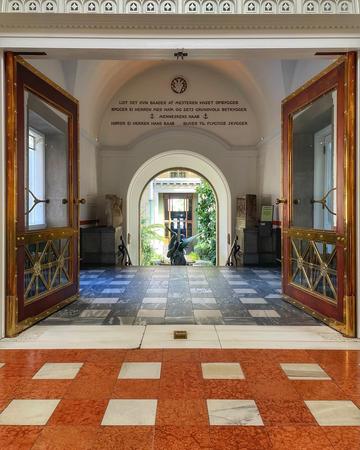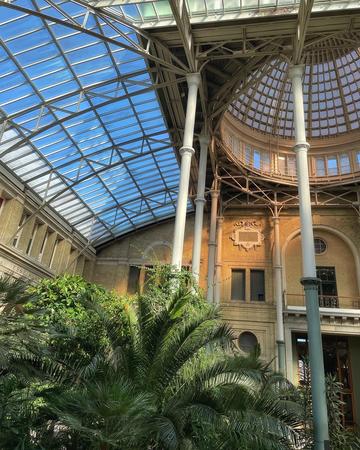Exhibiting Antiquity
A CAAH Fieldwork Placement with the Ny Carlsberg Glyptotek
The Heritage Partnerships Team is pleased to host this blog post by Cæcilie Lotz, who recently completed a fieldwork placement with the Ny Carlsberg Glyptotek in Copenhagen, supervised by Rune Frederiksen, Head of Collections, and Anna Minor, Project Officer. This placement, which was part of her Classical Archaeology and Ancient History degree, was brokered by the Heritage Partnerships Team in response to a call by the Faculty of Classics.
On my first day as an intern, I thought that the Glyptotek might be haunted, because I kept hearing screams. When I enquired with the staff they laughed and reminded me that the museum lies right next to Tivoli, Copenhagen’s central amusement park. Indeed, it is quite impressive that despite the slightly unnerving background noise, the Glyptotek is known to its visitors as a place of tranquility and contemplation. Namely, through a series of surveys conducted before and shortly after the pandemic it was made apparent that the visitors greatly enjoy spending time in the museum, as it takes them out of their busy everyday lives. Yet, the survey also revealed that the visitors do not feel that they have learned much about the ancient world after their visit. This might be surprising, as traditionally the primary function of a museum is to teach and share knowledge, but I think the findings of this survey say a lot about the nature of the Glyptotek. Because, in many ways it is so much more than a museum. Stepping through the grand doors of the monumental entrance, you are met with marble and pillars, a neoclassical grandeur that simultaneously awes and pacifies its audience. Even on busy days, people lower their voices as they walk, slowly, through the great display rooms. And at its heart is the winter garden, a true oasis in this Nordic capital, with a spring and palm trees reaching towards the domed greenhouse ceiling. There really is nothing quite like it. Yet, the Glyptotek is currently undergoing a fundamental change. For approximately five years, the museum has been making steps to replace its permanent exhibition of the ancient world, an exhibition which has remained largely unchanged since the Second World War. As an intern I was introduced to this extensive project and asked to help sort out the ideas and to fill in the gaps of the new exhibition plan. I was able to meet with the scholars involved with the project and the common objectives were very clear; there was a great incentive to improve the teaching quality of the space and to simply make it more accessible and relevant to today’s visitor. However, simultaneously, there was a concern of preservation. To preserve the legacy and the history of the Glyptotek as being the private collection and initiative of one man, Carl Jacobsen, who founded and built the museum in 1897 and to honour the incredible architecture and atmosphere of the building. The main challenge, which I think is also what makes it such a fascinating and unique project, is how to unite these objectives.

A view of the winter garden from the inside of the museum. Photo by Cæcilie Lotz.
I would arrive every morning shortly before 9, making my way up to the library. The space reminded me of the Somerville College library, with its wooden paneling and tall book shelves, so I felt quite at home. I would usually grab a hot chocolate from the cafeteria and then start the process of looking through the theme documents for the new exhibition, pulling out stacks of museum catalogues, browsing images of Classical Greece, Etruscan Italy and Ptolemaic Egypt. When I had a question, I would walk up the stairs and over the slightly terrifying grated pathway connecting the taller bookshelves, to see Anna Minor, who is project manager and who helped me with my day to day work at the museum. Sometimes she would take me along on small outings for the museum, like a visit to a local auction house to browse some possible artefacts of interest. If I had any specific queries I would go to Rune, the curator, or one of the other scholars working on the project, who were always very helpful and welcoming. Typically after lunch I would take a stroll in the museum, this was best on Mondays, when the Glyptotek is closed to visitors and I had it all to myself. I would enter from a door in the wall into the Archaic Greek exhibition and every time I felt as if I had stepped into another world. One of my favorite places to go was down the dark stairwell in the Egyptian section because it just felt so removed from the rest of the world, and it was quieter too. It felt almost like how I imagine it must be to stand in a real Egyptian tomb. Sometimes Rune would invite me to meetings in the afternoon and I was able to listen in on the decisions and problem solving that occupies the Glyptotek day to day. It was incredible to me how much teamwork and how many different skill sets are needed to run a museum and I felt very honoured that I was able to be part of this collaboration, even just for a couple of weeks.
For the end of my internship I had prepared a 20 minute presentation for Anna and Rune, which detailed the work I had done and my ideas concerning the exhibition project. It was very satisfying to be able to collect and share my thoughts in this way and while it was sad having to say goodbye to the staff and to give up my access badge at the end of the day, I also left feeling inspired and full of renewed energy. I can’t wait to walk through the halls of the Glyptotek when the new permanent exhibition has been installed, knowing all the work that went into it and feeling amazed that I played even just a tiny part in making it happen.
Cæcilie Lotz (she/her) is a Danish third year student at the University of Oxford, studying Classical Archaeology and Ancient History at Somerville College.

The pillars and ceiling of the winter garden. Photo by Cæcilie Lotz.


